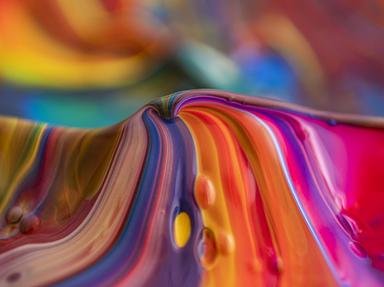Quiz Answer Key and Fun Facts
1. Ingres painted this aristocratic woman and her daughter. Both are simply dressed in white; the mother reclines upon blue-velvet cushions and wears a gauzy veil over her curly, black, upswept hair. She is wrapped in an ivory shawl with an embroidered border. The daughter stands before a landscape and wears long gold-colored gloves and a white swans-down boa. Her short hair is drawn back close to her head, accentuating her lovely round face and graceful neck. What was the surname of these two sitters?
2. This lady is rather simply dressed in blue-gray satin with a red ribbon in her hair. She stands in front of a mirror and looks directly at the viewer with her arms folded and with one hand, index finger extended, under her chin. The chief interest of this painting is the intelligent and rather questioning expression on the subject's face.
3. This portrait is a study in blue; the sitter wears a gown of Madonna-blue satin with a very full skirt and a lace shawl and cuffs. A bow of matching blue adorns her hair, along with a short veil. She stands before a wall hung with teal damask and leans against a gold-colored cushion, which echoes her gold bracelet and pendant and effectively contrasts with the abundant blue. She was the sister-in-law of another of Ingres' subjects.
4. The lady in this portrait is simply, but elegantly dressed in black, which matches her glossy black hair and large black eyes and sets off her exceptionally white skin. A faint blush rests upon her round cheeks and a faint smile plays around her delicate mouth. Her neck is as graceful and white as a swan's. Contrasting boldly with her black attire is a brilliant shawl resting on the arm of her chair, which features gold, orange, and white stripes each with a floral pattern, separated by black borders.
5. Ingres executed two contrasting portraits of this aristocratic lady, whose father was a prominent government official and whose husband was a lace merchant. In one portrait, she wears a black gown richly trimmed with black lace and stands silhouetted against a wall hung with rose-colored damask. Pale pink roses adorn her hair and she wears gold jewelry and holds a small gold fan. In another, she sits on a sofa upholstered in pink damask and wears a white gown brilliantly printed with multi-colored roses. Tassels of contrasting colors hang from the collar of her gown and she, again, holds a closed fan. A pink cap trimmed with white lace adorns the back of her head, visible in the mirror behind her in which her face can be seen in profile.
6. Ingres executed a smaller version of this splendid nude, painted in 1808. The sitter's face is turned from us; she wears a red and white turban nearly covering her hair. She is seated on a white cushion and is about to step into her bath. The prominent feature of this painting is the sitter's back; the soft texture of the flesh can almost be felt. The smaller version was painted in 1828; it differs in several details, but the figure's pose is identical in each. Which is it?
7. The woman in this allegorical painting is nude and stands in a grotto. She holds a large earthenware jug on her shoulder, whose contents she is pouring into a stream at her feet.
8. This nude reclines on a richly appointed bed, with blue-velvet cushions, a large square of fur, linen sheets, and a gold satin blanket. She has her back to us and looks over her shoulder. Her one article of clothing is a richly embroidered turban and she holds a peacock-feather fan in one hand. Her bed is hung with rich blue satin draperies embroidered with gold.
9. The subject of this painting is an elderly woman of no great physical beauty, but clearly possessed of a lively personality and great humor and wit. She is seated and wears a veil and a ruff around her neck. Her gown is of moss-green velvet. An embroidered shawl rests on the arm of her chair.
10. The woman in this portrait belonged to a prominent family of bankers, still in existence today. She wears a gown of rose-colored satin, trimmed with silver-blue lace. White plumes adorn her hair and she carries a small white fan. She sits with her chin resting on one hand facing the viewer.
11. This woman has the distinction of having been a pupil of Ingres. She is rather primly dressed in black, with white lace sleeves and collar and a lace cap. At her throat is a pink satin bow, the one bright spot of color in the painting.
12. Ingres was twice married, and painted portraits of both his wives.
13. The woman in this early portrait appears to be very young; she sits on a red-upholstered chair wearing a black velvet dress with short puffed sleeves. Wrapped around her is a gold-colored shawl, and she holds a half-opened golden fan. A rather enigmatic half-smile plays around her lips.
14. This portrait is one of a very few by Ingres which uses the sky as a backdrop. The bright outdoor light heightens the sitter's fresh beauty; her round cheeks are faintly touched with crimson, and her dark curls cling to her forehead. She wears a dress of coffee-colored satin with a brilliant scarlet cloak.
15. One of Ingres' best-known paintings is of this celebrated French historical figure.
Source: Author
jouen58
This quiz was reviewed by FunTrivia editor
fringe before going online.
Any errors found in FunTrivia content are routinely corrected through our feedback system.
